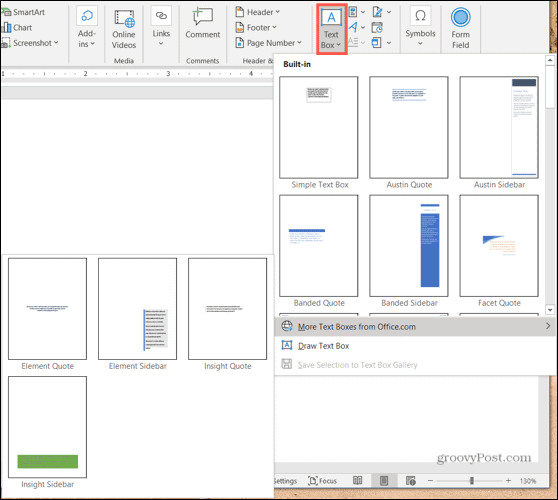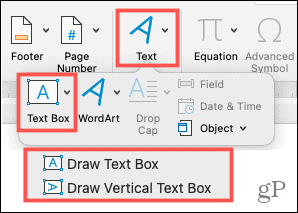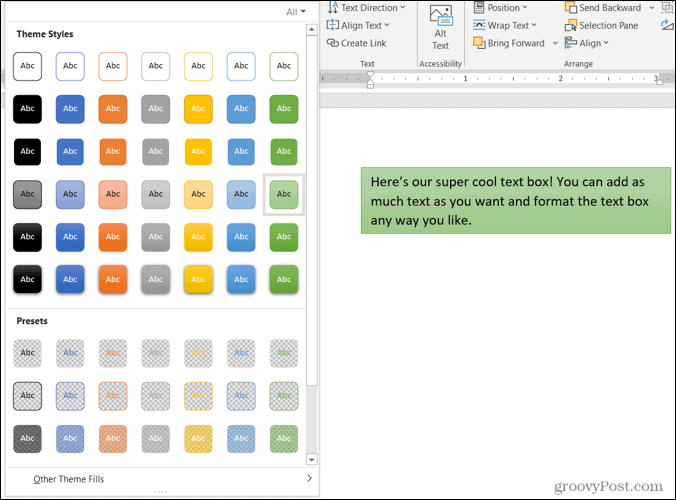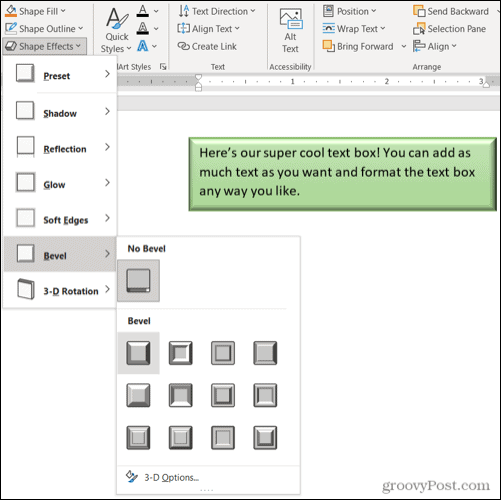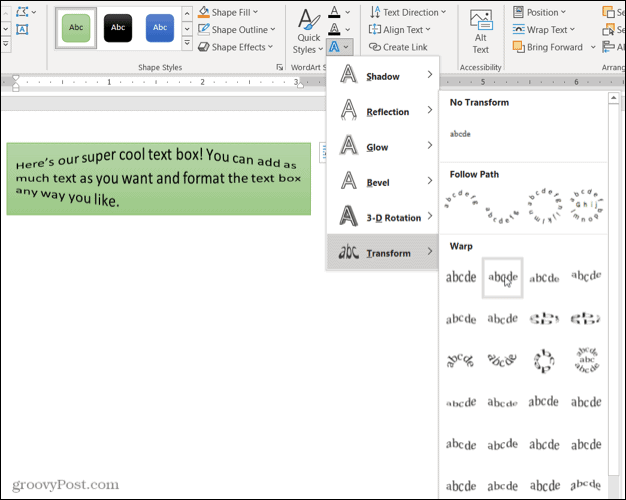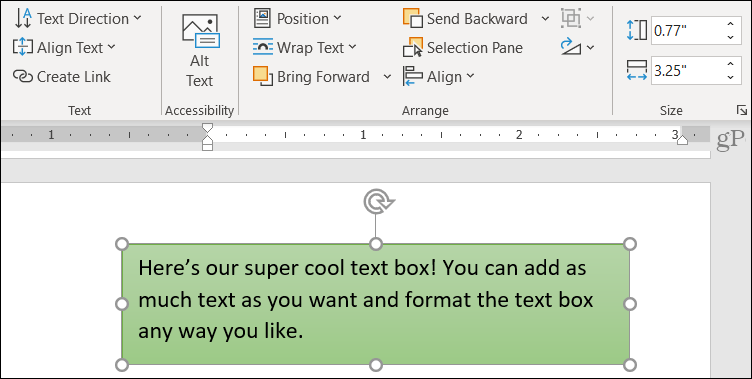Reading
a lengthy text document can make anyone bored in minutes. However, there are
few simple ways to make your documents more attractive and appealing to the
reader. One such option is to add colorful text boxes in-between paragraphs.
This is a useful way to show important action points on full text based
documents. In this article, let us explore how to create text box in Word
document.
Related: How to quickly add dividers in Word?
We
will discuss the following options based on Word 2016 or later version.
- Create text box from existing text
- Creating empty text box
- Changing text box size and position
- Changing text direction
- Deleting borders
Creating
Text Box from Existing Text
You can convert any of the existing text paragraph and list to a text box in Word. Let’s see how to do that.
- First open your document and select the paragraph you want to convert to a text box.
- Switch to the “Insert” tab from the ribbon menu.
- Open the “Text Box” menu.
- Word offers a selection of predefined text boxes, for example for creating sidebars with quotes.
- However, for converting the existing text, select the entry “Draw Text Box” in the lower pane.

This will instantly add a bordered text box around
the selected text. Word treats text boxes as a drawing and you can design the
box as per your need using the “Drawing Tools” menu. You can move the text
boxes anywhere in the document, depending on the layout. This can be useful for
the design of flyers and brochure.
Creating
Empty Text Box
Of course, you do not necessarily need existing text to
create a new text box. Alternatively, you can also create empty text boxes and
enter the text into them later.
- Place the cursor where you want to insert a text box.
- Reopen the “Insert” menu and select “Text Box” option.
- Click the “Draw Text Box” menu item. You will see the cursor now changed to cross hair shape.
- Draw out the text box while holding down the left mouse button.
- Then enter the text into the text box.
- You can look at the various options in the context menu of your text box for designing your text box.

Changing
Text Box Size and Position
When
you have created a text box out, you have various options for editing. You can
design it, change the size and place it anywhere in your document.
- You can change the size of the box using the handles on the edges of it. Word will automatically adjust the text content inside the box.
- It is also possible to freely move the box using the mouse. You can hover over the mouse to change the cursor into a star shape, allowing you to drag the box.
- Formatting is also possible as usual, for example, right-click on the selected text to use the Mini toolbar and format the text in bold or change the alignment.
- You can click on the “Layout Options” button on the side of the text box to wrap text box with the content on your document.

Changing
Text Direction
Within
a text box, you can also influence the text direction. Besides the default
horizontal alignment the text can also run vertically.
- What about if you want to rotate the text inside text box? This is also
very easy. Open the “Text Direction”. - Double click on the text box to open “Drawing Tools” menu. Click on the
“Text Direction” menu and select the entry, “Rotate all text 270°”. - The text is now set vertically in the text box and you can adjust the
format and position of the box.
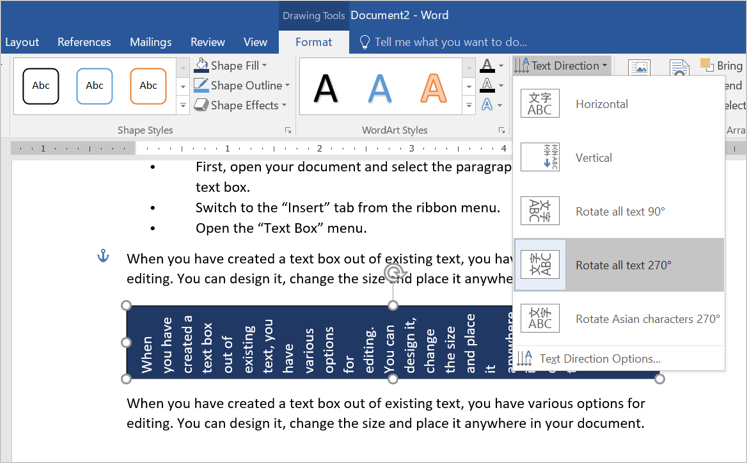
- You can move the text box between paragraphs or columns by dragging the
box while keeping the left mouse button pressed.
Related: How to embed Excel table in Word document?
Deleting
Borders and Content
By
default, text boxes are displayed with borders, but you do not have to keep
them. You can easily remove the borders.
- Click on the text box to open the “Drawing Tools” and select “Shape Outline”
button under “Format” menu. - Now, select the entry “No Outline” to remove the borders from the box.
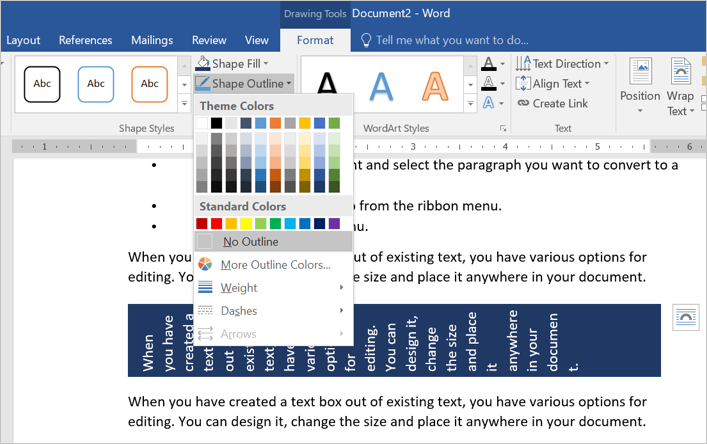
- You can also apply different colors, weight and styles to the border if
you want. - In order to delete a text box content, simply click inside the box and
edit or delete the content. Alternatively, select the text box by clicking on
the border and press delete to completely delete the box. - In this respect, text boxes behave in the same way as other drawing
objects.
Using Text Box Templates
The best and easy way to use text box in Word is to
select one of the predefined text box template. You can select from one of the good-looking
templates from the “Text Box” menu dropdown.

For example, you can use text box in a sidebar
format or choose one of the colorful formats. You can adjust the layout
positions to align the content beside the box.

You can also customize the text box and create a
custom template as a Quick Parts.
- First, select the box you want to use as templates.
- Go to “Insert > Text Box” and choose “Save Selection to Text Box Gallery” option.
- Fill up the details to create a new building block.
- You can view the saved template under “Text Box” menu dropdown from next time onwards.
Other Formatting Options
The “Formatting Tools” menu offers various
additional options for customizing your text box content. You can double click
on any text box to view the menus applicable for drawing object. Below are some
of the activities you can do with the formatting tools:
- Apply shape styles like fill, effects and borders.
- Create WordArt inside text box.
- Change text direction.
- Position and wrap the content around the text box.
If you’ve never used text boxes in Microsoft Word, you’re missing out on a handy feature. Here’s a quick introduction to using them.
It’s dead simple to type up a document in Microsoft Word: just click on a blank document and start typing. Of course, Word provides tons of options for formatting, fonts, and more to make your documents stand out.
One of these options is the text box. Why would you need a specific tool for inserting text when you can type it anywhere in a Word document? Let’s take a quick look at how to add customizable text boxes and why you might want to.
How to Add a Text Box in Word
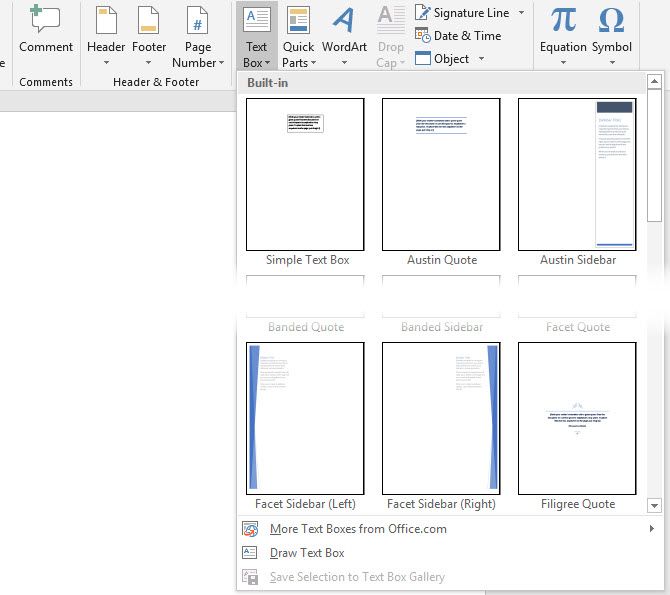
With a Word document open, switch to the Insert tab. In the Text section, you’ll see a Text Box entry.
Once you click this, you’ll see a variety of built-in options. These range from the basic Simple Text Box to more involved options like Banded Sidebar. Simply click the one you want to insert it into your document.
Word will place the text box into a default position with some generic text. Next, you can customize it to your needs.
How to Customize Text Boxes in Word
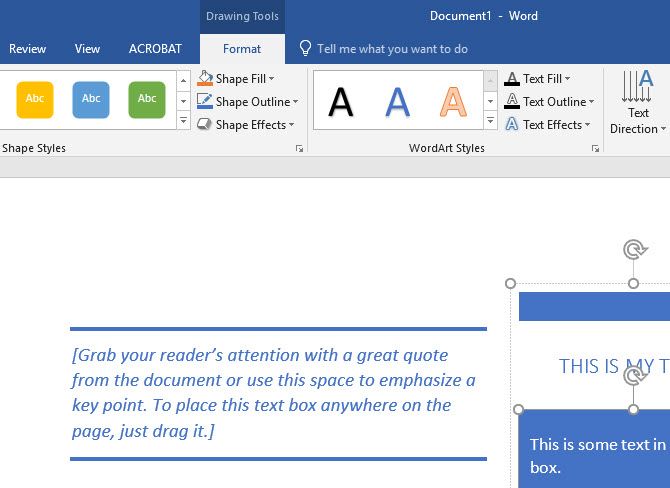
With a text box inserted into your document, you can click and drag the outline to move it anywhere on the page. Grab one of the handles and you can resize the box too.
Double-click inside the box to select the placeholder text and insert your own. When you’re working inside a text box, use the Format bar at the top of the page to change the colors, font style, alignment, and more.
Why Use Text Boxes in Microsoft Word?
For simple documents with standard layouts, you probably don’t need text boxes. But they can add a nice touch for more dynamic papers. They’re perfect for pull quotes, calling attention to the most important parts of your piece. You might use them for a statistical aside or graphically different text instead.
Try text boxes in your next document for an exciting touch! For more on Microsoft Word, check out hidden Microsoft Word features that make life easier and how to add watermarks to Word documents.
Image Credit: dennizn/Depositphotos
If you want to get creative with your text or simply have more flexibility, consider adding a customizing a text box in Word.
If you want more flexibility with certain text in your Word document, why not use a text box? Since a text box is considered an object, you can move it wherever you like in your document. This is handy for placing text in areas you normally wouldn’t.
You can use a text box to call attention to something in your document, rotate snippets of text, or create a unique appearance. Microsoft Word also provides formatting options for text boxes that give them their own nifty style or useful function.
Here, we’ll show you how to add or draw a text box and then format it to your liking in Microsoft Word.
With Word on Windows, you can either insert a preformatted text box or draw one of your own. Either way, you can customize it afterward, so choose the best option for you.
Go to the spot in your document where you want the text box and select the Insert tab. Click the Text Box drop-down arrow and pick a Built-In style or Draw a Text Box.
If you’re using Word on Mac, go to the Insert tab, click the Text drop-down arrow, and then the Text Box arrow. You can then choose to draw a simple text box or one where the text inside is vertical.
To draw your text box on either platform, drag the crosshairs to create the size you want. You can resize the text box any time after you draw it too.
When your text box appears, click inside to add your own words.
Format and Customize a Text Box in Word
Once you insert or draw your text box, select it and go to the Shape Format tab to view all of your formatting options. You’ll find the following features in Word on Windows, which may differ slightly in Word on Mac.
Shape Styles
Choose a theme or preset style for your text box. These options include filling colors and various effects.
Or you can use the Shape Fill, Outline, and Effects options to create your own distinctive style. From gradients and patterns to dashed lines and scribbles, you have many terrific options for customizing the appearance of your text box.
Note: Some options in the Shape Styles section may not be available if you select a preset text box.
WordArt Styles
Along with making the text box itself look snazzy, you can do the same with the text inside of it. Check out the Quick Styles in the WordArt Styles for premade options.
Or use the Text Fill, Outline, and Effects to make the text really pop. You can do things like add a shadow and glow or warp the text, so it’s curvy and cool.
Text, Accessibility, Arrange, and Size
The remaining sections of the ribbon allow you to change the direction of the text inside the box, use text wrapping with other elements in your document, rotate the text box, and adjust its exact size. You can also use the Alt Text Accessibility option to describe the text box.
Edit Your Text Box
After you customize your text box, you can still edit it anytime. Just note that when you select the text box to make changes, it may appear without some of the elements or effects you’ve applied. This is to make text editing simpler.
Once you complete your edits and deselect the text box, it will return to normal with your customizations.
Add Text Anywhere, Any Way in Word
Text boxes in Microsoft Word let you place text anywhere in your document without worries of margins or other normal text limitations. And because you can completely format the text box almost any way you want, it can be both a fun and useful addition to your document.
If you use Google Docs and Microsoft Word, take a look at how to work with text boxes in Docs too!
Introduction to Text Boxes
What you’ll learn to do: create and modify text boxes.
Things in a Microsoft Word document that are not text are called “objects.” The first object we will cover is a text box. Many of the controls and features of text boxes are also applicable to images, another important object in Microsoft Word.
Text Boxes
Learning Objectives
- Create and modify text boxes.
Text boxes are containers for text that can be customized and moved around. They are useful for emphasizing or decorating text.
Some examples of text boxes.
To add a textbox, go to Insert>Text>Text Box. There are a few pre-created Built-in options to choose from. Click one of the Built-ins to add it to the document. You can also draw your own by choosing Draw Text Box, then clicking and dragging where you want the text box to be.
Text Box menu
Drawing a text box
Once created, you can type in the text box, change the size of the text box, move the text box around, and even rotate the text box.
- Anchor point. The anchor is the point at which the text box intertwines with the rest of the document. Click the anchor icon to select the entire text box.
- Rotation control. Click the circular arrow and then drag to rotate the text box.
- Wrap text. This controls how content in the rest of the document interacts with the text box. Text can go around the text box, in front of the text box, or skip over the text box. Text wrap is covered in more detail in the Images section.
- Resize points. The white dots on the border of the text box control the width and height of the text box. Click and drag any of the white dots to move that side or corner.
To move the text box, hover your cursor near the edges of the box. When you see four arrows behind the cursor, you can click and drag the box wherever you want it.
Formatting Text Boxes
When you create a text box, a new tab will appear on the ribbon called Format. There are a lot of different tools in the Format tab, some of which may look familiar.
1. Shapes
The Shapes group (at the far left) allows you to change the shape of the text box. Click the Change Shape button in the Shapes group and then Change Shape to see a dropdown menu with many shape options. Click an option to apply it to the text box.
You can also create a custom shape using the Edit Points option (just below Change Shape). The points of the text box will be outlined. Click and drag the black dots to alter the shape of the text box.
2. Styles
Click the dropdown arrow to open a dropdown menu with a variety of styles for your text box. Some styles may have a gray checkered pattern. The gray checkered pattern indicates transparency. Hover over each effect to preview the results; click to apply the effect.
3. Text
The Text group of the Format tab gives you additional control of the text in the text box.
Text Direction
By default, text runs horizontal in the text box. But you can choose to rotate the text so that it runs vertically by choosing Rotate all text 90° or Rotate all text 270°.
Text Alignment
Text alignment of text boxes works much like text alignment in the main document. Instead of the margin or border of the page, the text aligns with the border of the text box.
Create Link
Create Link lets you create a link between two or more text boxes so that text can flow, or continue, from one text box to the next.
Select a text box, then click Create Link. The cursor will change into a paint bucket. Click on the second text box to link them. Once linked, anything typed in the first text box will flow over to the second. (Note that the second text box must be empty before you link to it.)
Practice Question
4. Arrange
The arrange option controls the order of text boxes and other elements on a page. Although a Word document is a two-dimensional file, arranging elements requires a bit of three-dimensional thinking.
The main document, where the main text is, is the bottom layer of the document. When you create a text box, the text box is on top of the rest of the document. Adding another text box puts the new text box on top of the first one.
With the Arrange option, the text box order can be rearranged.
- Bring forward brings the text box forward one spot.
- Send backward sends the text box backward one spot.
These options are also available when right-clicking on a text box:
- Bring to front brings the text box to the very front so that it is on top of everything else.
- Send to Back sends the text box to the very back so that everything else is on top of it.
The yellow text box has been brought to the front, while the blue text box has been sent to the back.
Shapes
Sometimes you may want just a shape with no text, or you may want to figure out what shape you want a text box to be before you add text.
To insert a shape, go to Insert>Shape and select a shape from the menu.
Once you select a shape, click and drag to draw the shape. You can then apply a text wrap, rotate the shape, or send the shape in front of or behind text.
|
Click and drag |
Square text wrap |
You can change the color or add other effects to the shape from the Format tab, which appears when you click on the shape.
If you decide you do want to add text to the shape, double-click on the shape and start typing to make the shape a text box.
Continue With the Mobile App | Available on Google Play
[Attributions and Licenses]
-
1
Click the Insert tab.
-
2
On the right side of all of the things you can insert, look for ‘Text Box.’
Advertisement
-
3
Select the text box that you want to use and double click on it.
-
4
Cut and paste the text into the text box.
Advertisement
Ask a Question
200 characters left
Include your email address to get a message when this question is answered.
Submit
Advertisement
Video
-
To change the size of the text box, click on it once, and drag one of the 8 circles.
-
You can change the design of the text box you have selected by going into the format tab.
Thanks for submitting a tip for review!
Advertisement
About This Article
Thanks to all authors for creating a page that has been read 98,464 times.
Is this article up to date?
wikiHow Tech Help Pro:
Level up your tech skills and stay ahead of the curve
Let’s go!


